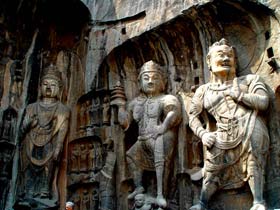

The world-famous Longmen Grottoes are located 12km south of Luoyang, where Xiang Hill and Longmen Hill stand facing each other. Yi River washes its wav northward through the gorge. Taken a distant view, Longmen Grottoes just like a pair of Chinese gate towers. So during the Zhou and Qin dynasties, it was called "Yi Que" (Gate of Yi River). Later, when the Sui established its capital city in Luoyang, the palace gate was just facing Yi Que, hence the name "Longmen" which means "Dragon Gate". These caves are considered one of the three great sculptural treasure troves in China. The other two are the Mògao caves in Dunhuáng (Gansu Province), and the Yúngang Grottoes in Dàtóng (Shanxi Province), the precursor to Lóngmén.) In general, the limestone is harder at Lóngmén than at Yúngang, and the caves closer to the river, making it easier to discern the details but more difficult to see the caves as a whole. In the year 2000, Longmen Grottoes was listed by UNESCO as a World Cultural Heritage Site.
The Longmen Grottoes were first sculptured and chiseled around 493AD when the capital of the Northern Wei Dynasty (386-534) was moved from Datong to Luoyang. At this time, Chinese Buddhism was reaching its first peak, and the emperor Taihe, himself was a pious believer. The entire construction of Longmen Grottoes lasted more than four hundred years through the Northern Dynasties, Sui Dynasty, Tang Dynasty and up to Song Dynasty. Benefactors of the Longmen Caves included imperial families, high-ranking officers, Buddhist leaders, and merchants as well as common folk, many of whom could only afford the smaller honeycomb niches. According to the statistical data by Longmen Caves Research Institute, there are still 2345 caves and niches, 100,000 Buddhist images ranging in size from 2 cm to 17.14 meters, more than 2800 inscribed tablets, and 43 Buddhist pagodas remaining in both East Hill and West Hill. About 30% of the caves are from the Northern Wèi dynasty (386-584); their statues are more elongated, static, and lacking in complexity and detail than the later Tang dynasty sculptures which account for about 60% of the caves, with their fuller figures, gentle features, and characteristic liveliness. This is an exceptional treasury and gallery of Chinese Buddhist art.
The section of Longmen Shíku currently open to visitors is concentrated in a 1km (1/2 mile) long stretch on the West Hill side of the Yi River. Morning is the best time to visit the Longmen Grottoes, which mainly face east and catch the light from the rising sun.
Although Longmen Caves mainly shows the Buddhist culture, it provides a large number of historical data for studying ancient religion, fine arts, architecture, calligraphy, music, dress, as well as medicine. Therefore, it has been considered as a large scaled stone-carved art museum.
Apart from the Longmen Caves is renowned for the caves; it is also endowed with lush mountains and ridges, springs and waterfalls. The two mountains are covered with green pines and cypresses. Towers and pavilions set each other off. It's a unique scenery area.

